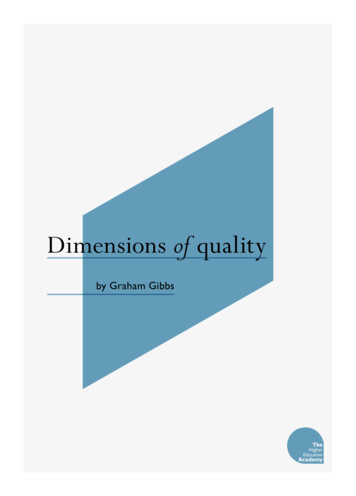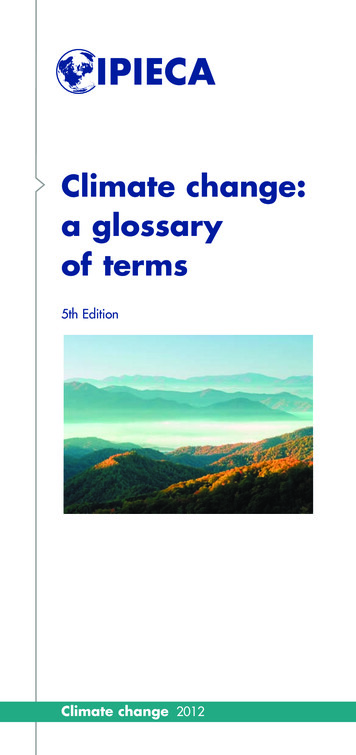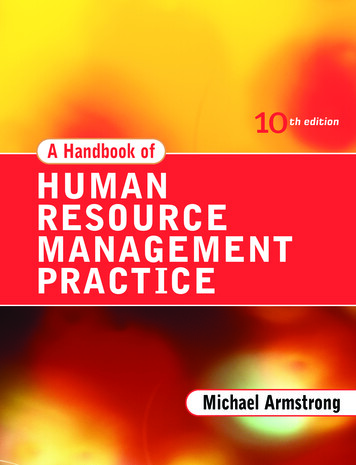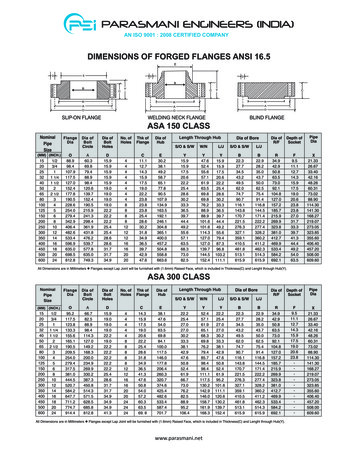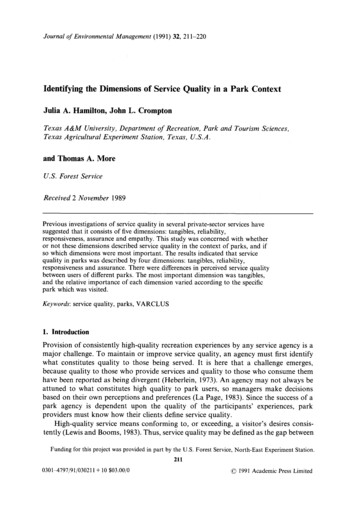
Transcription
Human Dimensions of WildlifeAn International JournalISSN: (Print) (Online) Journal homepage: https://www.tandfonline.com/loi/uhdw20Impacts of human-dimensions of wildlife trainingon participantsAnnetjie Siyaya, Courtney Hughes, Wesley R. White, Claire M. Nitsche &Laurie MarkerTo cite this article: Annetjie Siyaya, Courtney Hughes, Wesley R. White, Claire M. Nitsche &Laurie Marker (2021): Impacts of human-dimensions of wildlife training on participants, HumanDimensions of Wildlife, DOI: 10.1080/10871209.2021.1937754To link to this article: shed online: 18 Jun 2021.Submit your article to this journalArticle views: 9View related articlesView Crossmark dataFull Terms & Conditions of access and use can be found ation?journalCode uhdw20
HUMAN DIMENSIONS OF 754Impacts of human-dimensions of wildlife training onparticipantsAnnetjie Siyayaa, Courtney Hughesb, Wesley R. Whitec, Claire M. Nitschec,and Laurie MarkeraaEducation Department, Cheetah Conservation Fund, Otjiwarongo, Namibia; bFaculty of Agricultural, Life &Environmental Sciences, Department of Renewable Resources, University of Alberta, Edmonton, Alberta,Canada; cDepartment of Human Dimensions of Natural Resources, Colorado State University, Fort Collins,Colorado, USAABSTRACTKEYWORDSPeople who live in areas with high diversity often do not have accessto training opportunities because of the gaps in critical training areas,although a wealth of opportunities are available to conservation prac titioners. There is a need to offer cost-effective, strategic, evidencebased, sustainable, equitable, and adaptive capacity-building trainingto African conservation practitioners. Concerted training platformscould fill these gaps by providing learning opportunities while lever aging limited time and money. Forty-two African trainees participatedin 13 training sessions in Windhoek, Namibia, in 2018. Surveys wereadministered before and after training. Sixty-six percent of participantsstrongly agreed that the training was applicable to their work beforeand after training. Our results provide insight on the importance ofconservation training opportunities for mid-career wildlife managers,conservationists, and practitioners, including the need to ensure train ing opportunities are accessible and relevant to various people andtheir needs. Keywords: Human-dimensions, human-wildlife conflict,training, surveyHuman-dimensions; training;survey; human-wildlifeinteraction; educationAlthough a wealth of opportunities are available to conservation practitioners, people wholive in areas with high biodiversity often do not have access to conservation training becauseof the gaps in critical training areas (Bonine et al., 2003). Burgin et al. (2018) stated thatthere are 6,495 mammalian species on Earth, of which 96 are recently extinct. Therefore,conservation training is crucial, especially for African practitioners given that this continentis home to approximately one quarter of the world’s mammalian species (Kinzig &McShane, 2015). Africa also presents a unique conservation challenge because the majorityof humans here still live in rural areas and depend on natural resources for fulfilling theirlivelihood needs, leading to greater demand for food, fuels, and fibers, often at the expenseof biodiversity (O’Connell et al., 2019; Perrings & Halkos, 2015). There is a need to offercost-effective, strategic, evidence-based, sustainable, equitable, and adaptive capacity build ing training to African conservation practitioners (O’Connell et al., 2019). Dedicatedtraining efforts, such as those offered through some conference events, could help to: (a)address these needs, (b) provide learning and networking opportunities among conserva tion professionals who can help address common challenges, and (c) leverage limited timeCONTACT Annetjie Siyaya 2021 Taylor & Francis Group, LLCannetjie@cheetah.orgCheetah Conservation Fund, Otjiwarongo, Namibia
2A. SIYAYA ET AL.and money (Oester et al., 2017). Although short training workshops offered throughconference events are not a panacea for addressing the knowledge and skill gaps inconservation, they are one part of the toolbox that can help improve capacity among theAfrican conservation community.At an African conservation conference (Pathways Africa) that took place in Windhoek,Namibia in 2018, the human-wildlife conflict (HWC) challenges faced by mid-careerconservationists were evaluated, and the effectiveness of the training that was offered wasassessed. The three-day training took place three days prior to the conference with the aimsof helping to build capacity for on-the-ground wildlife conservation in Africa, and sharinglessons learned from around the continent and beyond. Forty-two participants from nineAfrican countries participated in 13 training sessions (Table 1). These sessions werepresented by 19 trainers from conservation institutions across the world, and includedboth theoretical and practical sessions. Paper-based questionnaires were administeredimmediately before the start of the first session and after the last session ended. Shortquestions were developed to evaluate training effectiveness, including: (a) enhanced knowl edge and skills, (b) application to current or future conservation challenges and, (c) ifparticipants intended to share information from the training once back in their country ofresidence.Table 1. Overview of the 13 training sessions.Training SessionLivestock Farm VisitProject LeadershipProject ManagementCommunicating with PeopleEnvironmental EducationWildlife Crime and TraffickingSocial and Wildlife MonitoringWorking with People to AchieveConservationLand Tenure and ManagementHuman-Wildlife ConflictConflict TransformationConservation EconomicsPride: Community BasedEducation VolunteerismOverviewIntroduction to integrated livestock, wildlife and rangeland management, and the useof livestock guarding dogs.Identify strengths and weaknesses, deal with workplace conflict, and providethoughtful strategic leadership.Introduction to business concepts and best practices, strategies for raising andmanaging project funding, guidance on growing and maintaining conservationproject.Elements of successful communication, including understanding an audience,carefully selecting the method or tool used to convey messaging, and learning howto craft a message that resonates with the target audience.Review role of environmental education and outreach in wildlife conservation, andbuild competencies in program design, implementation techniques, and evaluationconsiderations.Wildlife trade with an overview on the cheetah, actions to combat illegal wildlifetrade, and enforcement tools with safe handling of confiscated specimen.Introduction to social monitoring concepts, tools, and best practices, how to design,execute, and understand the results of social surveys.Understand the nature of human dimensions from an applied and researchperspective, and understand conservation is only achieved through working withpeople.Introduction to structure and maintenance of Namibia’s communal conservancysystem, explore similarities and differences with other land tenure systems, and diginto challenges and opportunities within each system.HWC and how it has evolved over time, outline complex social technical aspectsthrough combination of lecture, theoretical framing, concrete case studies, groupdiscussion, and interactive activities.Foundational concepts of conflict transformation and practice basic skills ofconciliation that can be immediately applied in the field.Use of environmental economics and ecosystem services to make the developmentcase for conservation.Pride as a case study of volunteer education programs.
HUMAN DIMENSIONS OF WILDLIFE3Eight questions were asked in the pre-training questionnaire, four of which weremeasured on a five-point scale (1 “strongly disagree,” 2 “disagree,” 3 “neutral,” 4 “agree,”5 “strongly agree;” Joshi et al., 2015). These questions focused on HWC, natural resourcemanagement, and human – wildlife coexistence. Thirty-six questions were asked in thepost-training questionnaire to evaluate training effectiveness, seven of which were mea sured on the same five-point scale as the one used in the pre-training questionnaire.Of the 42 participants, 30 (71%) were male and 12 (29%) were female, and 21 (50%) werein the 30– 39 age group. Thirty-one percent (n 13) of participants held a Bachelor’s oradvanced degree. Participants working in a rural setting represented 69% (n 29), whereasthose working in an urban setting represented 19% (n 8). Thirty-two different organiza tions were represented, of which 25% (n 8) were governmental and 75% (n 24) werenon-governmental (NGOs). Participants were from 10 different countries that representedfour African regions: East Africa (50%), Southern Africa (40%), Horn of Africa (7%), andNorth Africa (2%).Results from the pre-training questionnaire indicated that more than half of the parti cipants responded that the biggest challenge HWC presents in their country is “animalthreats” (55% n 22), followed by “compensation (e.g., financial compensation for livestockloss to predators)” (20%, n 8), “overuse by humans (e.g., overharvesting of naturalresources)” (18%, n 7), and “conflicts with research (e.g., conflict between variousstakeholders)” (3%, n 1). Most participants wanted to learn “skills to manage HWC”(58%, n 23), “HWC models that work” (18%, n 7) and “partnership” (18%, n 7).Ninety-three percent (n 39) of the participants agreed with the statement “It is importantto learn how to prevent and mitigate HWC;” 81% (n 34) agreed that “Wildlife and naturalresources should be the priority in community-based natural resource management(CBNRM);” and 86% (n 36) agreed that “It is possible for individuals and communitiesto coexist with wildlife.”Results from the post-training questionnaire showed that 98% (n 41) agreed that “Thetraining has improved my confidence and skills to address human-dimensions issues in mywork.” Ninety-two percent (n 39) of participants also agreed that “I will be able to applymost of the knowledge and skills I learned to my job.” McNemar’s chi square groupdifference between participants’ level of response to the statement “The knowledge andskills I learn from the training will be applicable to my work” before and after trainingindicated an insignificant association likely due to the small sample size, but a medium phieffect size (X2 (1, N 35) 2.29, p .130, phi .39). More participants indicated “stronglyagree” before and after training (66%, n 23) compared to those who indicated “agree” or“neutral” (14%, n 5; Table 2). Both females (67%, n 6) and males (81%, n 21)maintained similar agreement to the statement “The knowledge and skills I learn fromTable 2. Frequency and percentage response to work applicability question pre- and post-training.Post-trainingPre-trainingStrongly Agreen (%)Agree or Neutraln (%)Agree or Neutraln (%)6 (17)Strongly Agreen (%)23 (66)5 (14)1 (3)Statistical value(X2 (1, N 35) 2.29, p .130, phi .39)
4A. SIYAYA ET AL.the training will be applicable to my work” before and after training. Additionally, irre spective of qualification, more participants (83%, n 29) maintained their level of agree ment with this statement before and after training. Participants also noted five commonthemes relative to new knowledge and skills developed, including: community engagement/involvement (25%), communication (25%), conflict resolution (20%), leadership (15%), andmanagement (15%).Our findings are consistent with those of Bonine et al. (2003) where the majority ofparticipants in these training sessions were young, male, educated in the sciences, andworked for NGOs. Findings were also consistent with O’Connell et al. (2019) who high lighted key areas of African conservation capacity building, including effective leadership,community engagement, and management.The Pathways Africa Training was effective in providing skills and capacity, as well ashelping improve participants’ confidence to address human dimensions issues. Theseopportunities are not always readily available in developing countries, with barriers includ ing costs and accessibility of training, and expertise required. The Pathways Africa Trainingorganizers offered scholarships to help participants address these barriers, and providedtake-home materials for participants as well as contact information of training sessioninstructors.Although conservation-based positions are commonly found in NGOs, representation ofparticipants from both government and NGOs indicates the need in both sectors for newinitiatives and collaboration through enhanced multidisciplinary learning (Lucas et al.,2017; Oester et al., 2017). NGOs help provide the expertise that aids government agenciesin policies and decisions, especially in the African context (Lekorwe & Mpabanga, 2007).Findings here provide insight on the importance of conservation training opportunitiesfor mid-career wildlife managers, conservationists, and practitioners, including the need toensure that training opportunities are accessible and relevant to a variety of people and theirneeds. Successful conservation actions are dependent on the capacity of people to success fully implement their projects or programs. The Pathways Conferences and associatedtrainings are one way to provide African (or other) participants with a variety of capacitybuilding, mentoring, and networking opportunities that help advance conservationsolutions.ReferencesReferencesBonine, B., Reid, J., & Dalzen, R. (2003). Training and education for tropical conservation.Conservation Biology, 17(5), 1209–1218. rgin, C. J., Colella, J. P., Kahn, P. L., & Upham, N. S. (2018). How many species of mammals arethere? Journal of Mammalogy, 99(1), 1–14. https://doi.org/10.1093/jmammal/gyx147Joshi, A., Kale, S., Chandel, S., & Pal, D. K. (2015). Likert scale: Explored and explained. BritishJournal of Applied Science & Technology, 7(4), 396–403. https://doi.org/10.9734/BJAST/2015/14975Kinzig, A. P., & McShane, T. O. (2015). Conservation in Africa: Exploring the impact of social,economic and political driers on conservation outcomes. Environmental Research Letters, 10(9),090201. we, M., & Mpabanga, D. (2007). Managing non-governmental organizations in Botswana. TheInnovation Journal: The Public Sector Innovation Journal, 12(3), 1–18. https://www.icnl.org/wpcontent/uploads/Botswana bots.pdf .
HUMAN DIMENSIONS OF WILDLIFE5Lucas, J., Gora, E., & Alfonso, A. (2017). A view of the global conservation job market and how tosucceed in it. Conservation Biology, 31(6), 1223–1231. https://doi.org/10.1111/cobi.12949O’Connell, M. J., Nasirwa, O., Carter, M., Farmer, K. H., Appleton, M., Arinaitwe, J, Bhanderi, P.,Chimwaza, G., Copsey, J., Dodoo, J., Duthie, A., Gachanja, M., Hunter, N., Karandja, B.,Komu, H. M., Kosgei, V., Kuria, A., Magero, C., Manten, M., & Wilson, E. (2019). Capacitybuilding for conservation: Problems and potential solutions for sub-Saharan Africa. Oryx, 53(2),273–283. https://doi.org/10.1017/S0030605317000291Oester, S., Cigliano, J. A., Hind-Ozan, E. D., & Parsons, C. M. (2017). Why conferences matter: Anillustration from the international marine conservation congress. Frontiers in Marine Science, 4,257. https://doi.org/10.3389/fmars.2017.00257Perrings, C., & Halkos, G. (2015). Agriculture and the threat to biodiversity in sub-Saharan Africa.Environmental Research Letters, 10(9), 095015. https://doi.org/10.1088/1748-9326/10/9/095015
post-training questionnaire to evaluate training effectiveness, seven of which were mea-sured on the same five-point scale as the one used in the pre-training questionnaire. Of the 42 participants, 30 (71%) were male and 12 (29%) were female, and 21 (50%) were in the 30- 39 age group.

